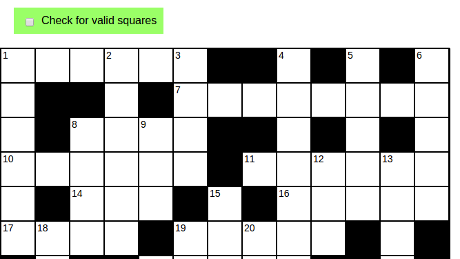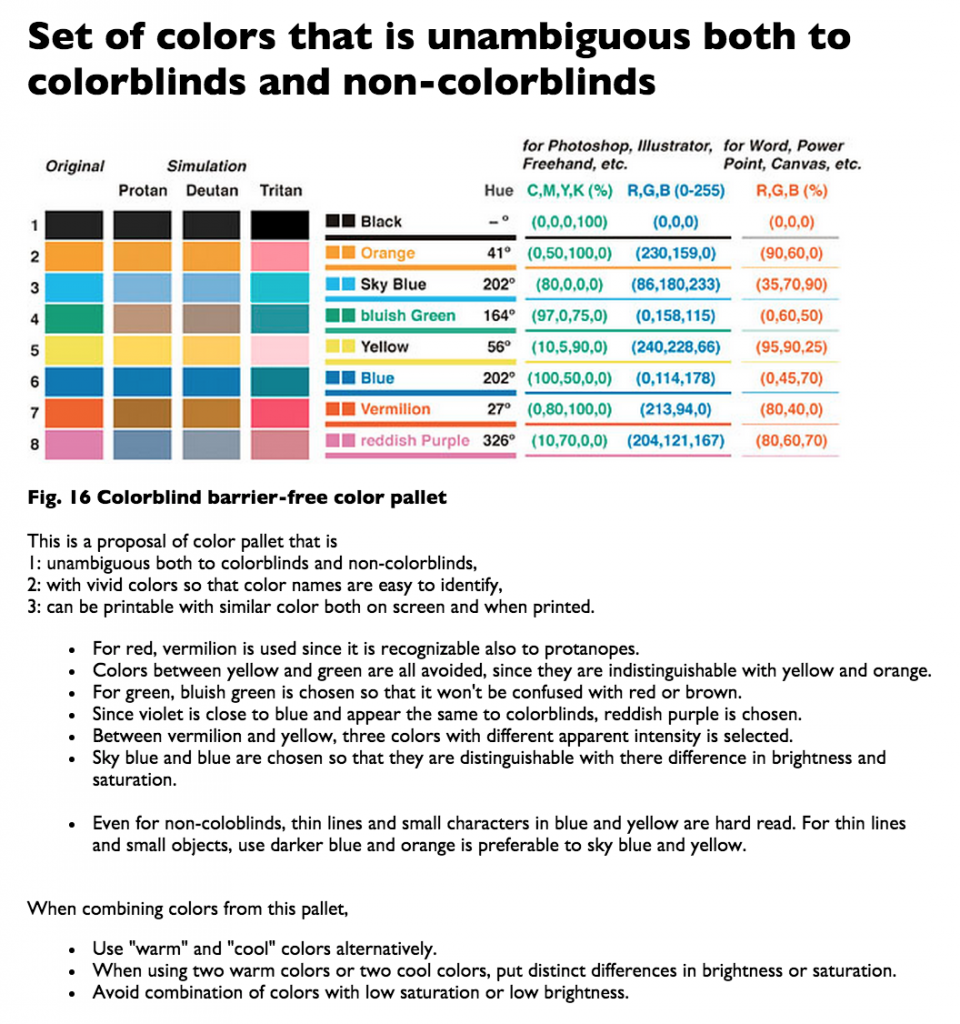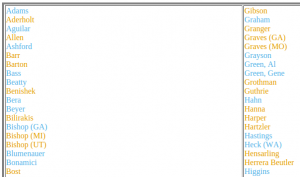Use Case
You should be familiar with the W3C Bibliography Generator. You can insert one or more URLs and the generator produces correctly formatted citations for W3C work products.
It’s quite handy but requires a URL to produce a useful response. I need authors to use correctly formatted W3C citations and asking them to find URLs and to generate correct citations was a bridge too far. Simply didn’t happen.
My current attempt is to produce a list of correctly W3C citations in HTML. Authors can use CTRL-F in their browsers to find citations. (Time will tell if this is a successful approach or not.)
Goal: An HTML page of correctly formatted W3C Recommendations, sorted by title (ignoring case because W3C Recommendations are not consistent in their use of case in titles). “Correctly formatted” meaning that it matches the output from the W3C Bibliography Generator.
Resources
As a starting point, I viewed the source of http://www.w3.org/2002/01/tr-automation/tr-biblio.xsl, the XSLT script that generates the XHTML page with its responses.
The first XSLT script imports two more XSLT scripts, http://www.w3.org/2001/08/date-util.xslt and http://www.w3.org/2001/10/str-util.xsl.
I’m not going to reproduce the XSLT here, but can say that starting with <stylesheet> and ending with </stylesheet>, inclusive, I came up with 604 lines.
You will need to download the file used by the W3C Bibliography Generator, tr.rdf.
XQuery Script
I have used the XQuery script successfully with: BaseX 8.3, eXide 2.1.3 and SaxonHE-6-07J.
Here’s the prolog:
declare default element namespace "http://www.w3.org/2001/02pd/rec54#";
declare namespace rdf = "http://www.w3.org/1999/02/22-rdf-syntax-ns#";
declare namespace dc = "http://purl.org/dc/elements/1.1/";
declare namespace doc = "http://www.w3.org/2000/10/swap/pim/doc#";
declare namespace contact = "http://www.w3.org/2000/10/swap/pim/contact#";
declare namespace functx = "http://www.functx.com";
declare function functx:substring-after-last
($string as xs:string?, $delim as xs:string) as xs:string?
{
if (contains ($string, $delim))
then functx:substring-after-last(substring-after($string, $delim), $delim)
else $string
};
Declaring the namespaces and functx:substring-after-last from Patricia Walmsley’s excellent FunctX XQuery Functions site and in particular, functx:substring-after-last.
<html>
<head>XQuery Generated W3C Recommendation List</head>
<body>
<ul class="ul">
Start the HTML page and the unordered list that will contain the list items.
{
for $rec in doc("tr.rdf")//REC
order by upper-case($rec/dc:title)
If you sort W3C Recommendations by dc:title and don’t specify upper-case, rdf:PlainLiteral: A Datatype for RDF Plain Literals,
rdf:PlainLiteral: A Datatype for RDF Plain Literals (Second Edition), and xml:id Version 1.0, appear at the end of the list sorted by title. Dirty data isn’t limited to databases.
return <li class="li">
<a href="{string($rec/@rdf:about)}"> {string($rec/dc:title)} </a>,
{ for $auth in $rec/editor
return
if (contains(string($auth/contact:fullName), "."))
then (concat(string($auth/contact:fullName), ","))
else (concat(concat(concat(substring(substring-before(string($auth/\
contact:fullName), ' '), 0, 2), ". "), (substring-after(string\
($auth/contact:fullName), ' '))), ","))}
Watch for the line continuation marker “\”.
We begin by grabbing the URL and title for an entry and then confront dirty author data. The standard author listing by the W3C creates an initial plus a period for the author’s first name and then concatenates the rest of the author’s name to that initial plus period.
Problem: There is one entry for authors that already has initials, T.V. Raman, so I had to account for that one entry (as does the XSLT).
{if (count ($rec/editor) >= 2) then " Editors," else " Editor,"}
W3C Recommendation,
{fn:format-date(xs:date(string($rec/dc:date)), "[MNn] [D], [Y]") },
{string($rec/@rdf:about)}. <a href="{string($rec/doc:versionOf/\
@rdf:resource)}">Latest version</a> \
available at {string($rec/doc:versionOf/@rdf:resource)}.
<br/>[Suggested label: <strong>{functx:substring-after-last(uppercase\
(replace(string($rec/doc:versionOf/@rdf:resource), '/$', '')), "/")}\
</strong>]<br/></li>} </ul></body></html>
Nothing remarkable here, except that I snipped the concluding “/” off of the values from doc:versionOf/@rdf:resource so I could use functx:substring-after-last to create the token for a suggested label.
Comments / Omissions
I depart from the XSLT in one case. It calls http://www.w3.org/2002/01/tr-automation/known-tr-editors.rdf here:
<!-- Special casing for when we have the name in Original Script (e.g. in \
Japanese); currently assume that the order is inversed in this case... -->
<:xsl:when test="document('http://www.w3.org/2002/01/tr-automation/\
known-tr-editors.rdf')/rdf:RDF/*[contact:lastNameInOriginalScript=\
substring-before(current(),' ')]">
But that refers to only one case:
<REC rdf:about="http://www.w3.org/TR/2003/REC-SVG11-20030114/">
<dc:date>2003-01-14</dc:date>
<dc:title>Scalable Vector Graphics (SVG) 1.1 Specification</dc:title>
Where Jun Fujisawa appears as an editor.
Recalling my criteria for “correctness” being the output of the W3C Bibliography Generator:

Preparing for this post made me discover at least one bug in the XSLT that was supposed to report the name in original script:
<:xsl:when test=”document(‘http://www.w3.org/2002/01/tr-automation/\
known-tr-editors.rdf’)/rdf:RDF/*[contact:lastNameInOriginalScript=\
substring-before(current(),’ ‘)]”>
Whereas the entry in http://www.w3.org/2002/01/tr-automation/known-tr-editors.rdf reads:
<rdf:Description>
<rdf:type rdf:resource=”http://www.w3.org/2000/10/swap/pim/contact#Person”/>
<firstName>Jun</firstName>
<firstNameInOriginalScript>藤沢 淳</firstNameInOriginalScript>
<lastName>Fujisawa</lastName>
<sortName>Fujisawa</sortName>
</rdf:Description>
Since the W3C Bibliography Generator doesn’t produce the name in original script, neither do I. When the W3C fixes its output, I will have to amend this script to pick up that entry.
String
While writing this query I found text(), fn:string() and fn:data() by Dave Cassels. Recommended reading. The weakness of text() is that if markup is inserted inside your target element after you write the query, you will get unexpected results. The use of fn:string() avoids that sort of surprise.
Recommendations Only
Unlike the W3C Bibliography Generator, my script as written only generates entries for Recommendations. It would be trivial to modify the script to include drafts, notes, etc., but I chose to not include material that should not be used as normative citations.
I can see the usefulness of the bibliography generator for works in progress but external to the W3C, citing Recommendations is the better course.
Contra Search
The SpecRef project has a searchable interface to all the W3C documents. If you search for XQuery, the interface returns 385 “hits.”
Contrast that with using CNTR-F with the list of recommendations generated from the XQuery script, controlling for case, XQuery produced only 23 “hits.”
There are reasons for using search, but users repeatedly mining results of searches that could be captured (it was called curation once upon a time) is wasteful.
Reading
I can’t recommend Patricia Walmsley’s XQuery 2nd Edition strongly enough.
There is one danger to Walmsley’s book. You will be so ready to start using XQuery after the first ten chapters it’s hard to find the time to read the remaining ones. Great stuff!
You can download the XQuery file, tr.rdf and the resulting html file at: 35LinesOfXQuery.zip.




